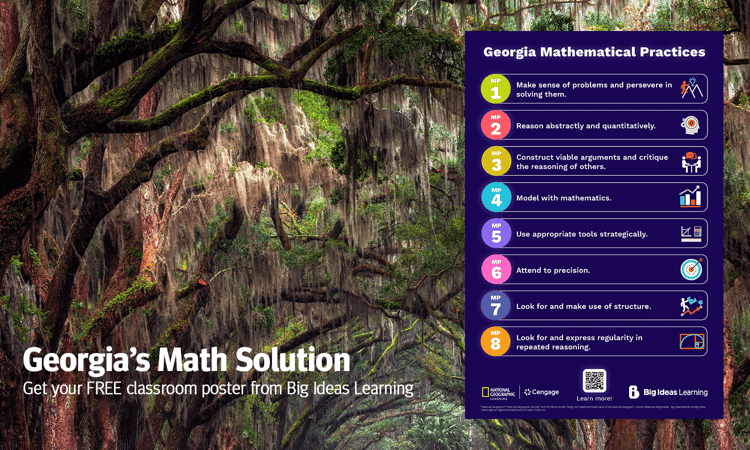Your Georgia Math Solution
Introducing Georgia's K-12 Mathematics Standards
Big Ideas Learning is eager to put down roots in The Peach State with a focused, rigorous, and comprehensive K-12 math program. This math series empowers Georgia educators and ignites student learning from kindergarten through high school (K-12).
Your Georgia Math Solution
Georgia Math embraces Dr. John Hattie’s Visible Learning Research
Learning Targets and Success Criteria consistently provide a framework to help students and teachers understand the purpose and intention of each lesson and a means of assessing student learning.
Your Georgia Math Solution
100% Aligned to the Georgia's K-12 Mathematics Standards
Georgia Math provides a cohesive, coherent, and rich mathematics curriculum that encourages students to become strategic thinkers and problem solvers.
Understanding Georgia’s K-12 Standards for Mathematical Practice

In 2021, Georgia updated the Mathematics Content Standards for all students. In Georgia’s K-12 Mathematics Standards Explanation of Changes and Improvements, one of the stated rationales for making changes and improvements to the standards is to focus on strategic mathematical thinking and reasoning, highlighting the importance of teaching the content standards through the lens of the Mathematical Practices (MPs). Therefore, working to appropriately embed these practices throughout each lesson is fundamental to helping students gain mastery of mathematical concepts and skills.
The Mathematical Practices describe the reasoning behaviors students should develop as they build an understanding of mathematics – the “habits of mind” that help students become mathematical thinkers. There are eight standards, which apply to all grade levels and conceptual categories. Developing these habits of mind builds students’ capacity to become mathematical thinkers.
The Standards of Mathematical Practices (SMPs) can be made more impactful if the text is interpreted in terms of behaviors one should expect to observe as students engage with each MP. Ideally, students would view the bulleted statements as the success criteria by which they could self-assess their ability to fully reason with mathematics on a regular basis.
FREE Georgia Math Poster for your Classroom
Big Ideas Learning is helping teachers and students understand Georgia's K-12 Standards for Mathematical Practice with a FREE poster for your classroom.
MP1: Make sense of problems and persevere in solving them.
Mathematicians who make sense of problems and persevere in solving them:
- Analyze the problem in a way that makes sense given the task.
- Create a plan for solving the problem.
- Continually ask themselves, “Does this make sense?” as they work through a task.
- Modify their methods as necessary when solving a challenging task.
- Make sense of and explain connections among mathematical ideas and various representations.
- Stay engaged and maintain a positive mindset when working to solve problems.
- Verify their solutions, as well as understand solutions presented by others.
To incorporate MP1 effectively in the classroom, teachers can help students by cultivating a community of growth mindset learners. They can foster perseverance in students by choosing tasks that are interesting and challenging, involving meaningful mathematics. Teachers should look to present problems that allow for multiple strategies and multiple solutions. Importantly, teachers should recognize students’ efforts when solving challenging problems.
MP2: Reason abstractly and quantitatively.
Mathematicians who reason abstractly and quantitatively:- Make sense of quantities and relationships in problem situations.
- Flexibly move between the context and abstract representations of problem situations.
- Remove the context from a problem situation, produce a symbolic representation of the problem, manipulate the symbolic representation, and put it back in context.
- Express connections between concepts and representations.
- Understand and correctly use the units involved in the problem situation.
- Attend to the meaning of quantities when choosing a representation based on a given context.
- Flexibly use properties of operations.
To incorporate MP2 effectively in the classroom, teachers can help students by providing opportunities for students to use manipulatives when investigating concepts. They can guide students from concrete to pictorial to abstract representations as understanding progresses and expect students to give meaning to all quantities in a task. Additionally, teachers should give students many opportunities to see how various representations are useful in different situations.
MP3: Construct viable arguments and critique the reasoning of others.
Mathematicians who construct viable arguments and critique the reasoning of others:
- Construct possible arguments based on stated assumptions, definitions, and previously established results.
- Use counterexamples appropriately.
- Analyze the arguments of others and ask probing questions to clarify or improve the arguments.
- Compare the effectiveness and efficiency of two or more plausible arguments.
- Recognize errors and suggest how to correct those errors.
- Justify results by explaining mathematical ideas, vocabulary, and methods effectively.
To incorporate MP3 effectively in the classroom, teachers should establish a culture in which students ask questions of the teacher and their peers, and error is an opportunity for learning.
They should select, sequence, and present student work to advance and deepen understanding of correct and increasingly efficient methods. Additionally, teachers should help students develop their ability to justify methods and compare their responses to the responses of their peers.
MP4: Model with mathematics.
Mathematicians who model with mathematics:- Apply prior knowledge to independently model, understand, and represent real-world problems.
- Identify, analyze, and draw conclusions about quantities using tools such as diagrams, two-way tables, graphs, flowcharts, and formulas.
- Use assumptions and approximations to make a problem simpler.
- Perform investigations to gather data or determine if a method is appropriate.
- Check to see if an answer makes sense within the context of a situation, possibly improving/revising the model.
To incorporate MP4 effectively in the classroom, teachers should provide opportunities for students to create models, both concrete and abstract, and perform investigations. They should ask students to justify their choice of model and the thinking behind it, as well as the appropriateness of the model chosen. Teachers can also assist students in seeing and making connections among different models.
MP5: Use appropriate tools strategically.
Mathematicians who use appropriate tools strategically:- Make good decisions about which tools to use and how to use the tools in specific situations.
- Use technological tools to visualize, analyze, and help solve problems, and to deepen math knowledge.
- Identify and use external math resources to pose and solve problems.
- Use estimation and other mathematical knowledge to detect possible errors.
To incorporate MP5 effectively in the classroom, teachers should help students see why the use of manipulatives, rulers, compasses, protractors, calculators, statistical software, and other tools will aid their problem-solving processes. They should make sure that math tools are readily available and frequently model the use of appropriate tools. Teachers should give students a choice of materials/tools and have discussions with them about their choices to lead them to use appropriate tools strategically.
MP6: Attend to precision.
Mathematicians who attend to precision:- Communicate their understanding precisely to others using proper mathematical language.
- Use clear and precise definitions in discussion with others and in their own reasoning.
- Calculate accurately and efficiently, and express answers to the appropriate degree of precision.
- Are careful about the meaning of units and clearly and accurately label diagrams.
To incorporate MP6 effectively in the classroom, teachers should consistently model the use of precise mathematics language and symbols and expect their students to do the same. They should ask students to identify symbols, quantities, and units in a clear manner. Teachers should also set expectations as to how precise the solution needs to be and help students understand when estimates are appropriate for the situation.
MP7: Look for and make use of structure.
Mathematicians who look for and make use of structure:- Recognize patterns, structures, and relationships within quantities, processes, and expressions, and across topics.
- Use properties and operations to make sense of problems.
- Use patterns, structures, multiple representations, and relationships to identify an effective and efficient solution path.
- Decompose a complex problem into manageable parts.
- Use patterns and repeated reasoning to solve complex problems.
To incorporate MP7 effectively in the classroom, teachers should encourage students to look for structure, not simply to apply a rule or structure given by the teacher. This means encouraging students to notice key features, such as identifying characteristics of shapes or noticing whether the order in which you add numbers changes the sum. Patterning activities also support attention to structure. Teachers can ask young children to identify the part of a pattern that repeats over and over and can ask older children to figure out a rule for predicting a new instance in a growing pattern or function table.
MP8: Look for and express regularity in repeated reasoning.
Mathematicians who look for and express regularity in repeated reasoning:- Identify repeated reasoning in calculations or processes to generalize.
- Build on prior learning to make and apply generalizations to new situations.
- Use recognition of repeated reasoning to help identify and understand procedural shortcuts.
- Continually evaluate the reasonableness of intermediate results, such as comparing results to estimates.
To incorporate MP8 effectively in the classroom, teachers should present several opportunities to reveal patterns or repetition in thinking, so students can make a generalization or rule. They should help students connect new tasks to prior concepts and tasks, to extend learning of a mathematic concept. Additionally, teachers should ask for predictions about solutions at midpoints throughout the solution process.
Teachers should look for ways to integrate appropriate SMPs in authentic ways to deepen students’ understanding of the mathematics content standards. Ultimately, the goal should be to engage students in rich, high-level mathematical tasks that support the approaches, practices, and habits of mind which are called for within these standards.
